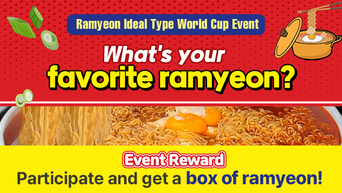
Nongshim
The Hallyu wave has seen K-Pop, K-Dramas, and even K-Beauty become some of the hottest exports to leave South Korean shores. However, there is another star contender amidst those categories and that is none other than K-Food. Be it Korean snacks, side dishes like kimchi, or even alcohol like soju and makgeolli – K-Food has become one of the essentials that K-Culture fans can’t live without.
In particular, Korean ramen, ramyeon (also spelled as ‘Korean ramyun’ – more on this later) has become one of the top exports from South Korea. According to the Korea Customs Service’s export and import trade statistics, the value of ramen exports reached over 100 million US dollars in April 2024, up 46.8% from the previous year.
In the spirit of sharing in the global love of ramen, Kpopmap has created a Korean Ramyeon Ideal Type World Cup in which K-Food fans can vote for their personal ramen GOAT (the greatest ramyeon of all time) and even stand a chance to win a box of it sent right to their doorsteps! Participate in the event (valid until the end of June 2024) now!

Comment Your Favorite Ramyeon And Win A Box Of It Delivered To You!EventsJun 7, 2024
But what makes people so obsessed with these instant noodles? Here’s an ultimate guide to give you info on why ramen has become a K-Food champion in the very literal hunger games.
Korean Ramen 101: Everything You Need To Know About These Instant Noodles
The Korean Soul Food – What Is Ramyeon And Why Is It Such A Staple Food?
Ramyeon (라면 in Korean) is an instant noodle dish that is originally steamed, fried, then dried. It is then included in a packet with soup powder and sometimes additional flakes for artificial flavoring.
Ramyeon is a soul food for Koreans and a staple in their diets for many reasons. Firstly, it is available anywhere, is affordable, has a long shelf life, and is also easy to cook quickly. Even those with no particular cooking knowledge can make delicious ramyeon. Like most soul foods, it may not be the healthiest food. However, recently, non-fried noodles have become a new trend thanks to an increase in health-consciousness, and products such as non-fried noodles, rice noodles, and more have gained traction in the ramyeon market, as well.
Additionally, it can be found in many shapes, forms, and flavors. There are pack noodles, bowl noodles, and dosirak (lunchbox) noodles that make ramyeon even more valuable as a ready-to-cook-and-eat food item. You can read more about ramyeon and its evolution on Nongshim’s Ramyun Pedia.
If you’re a fan of K-Dramas or K-Variety shows, you’ve probably seen the delicious meal on your screen countless times; like this scene between Seo KangJoon and Kim GoEun from the 2016 K-Drama “Cheese in the Trap“.
More recently, you might’ve seen the scene in “The 8 Show” where the characters all crave the same special meal whilst they are trapped in the experiment; a piping bowl of ramyeon. They then proceed to gather and eat an imaginary portion of this comfort dish because, at the end of the day, just the sentiment of pretending to eat it makes them feel rooted in reality.
Alternatively, you might be familiar with the classic rom-com K-Drama line, “Ramyeon meokgo gallae?” Whilst the meaning of this line is just as spicy as the ramyeon itself, it once again proves that the noodle dish is a common denominator that can’t be denied as a Korean soul food.
The reason ramyeon is eaten so often in productions replicates the frequency at which it is eaten by Koreans in real life. If you ask most Koreans what their top five soul foods are, they are more than likely to include ramyeon as one of them.
Ramen vs. Ramyeon vs. Ramyun: What’s With The Different Spellings?
A common question among fans of this K-Food is what the difference between the different spellings ‘ramyeon’, ‘ramyun’, and ‘ramen’ is, as even K-Food companies use different spellings on the English packaging of their products.
Firstly, the spelling ‘ramen’ (라멘 in Korean) is most commonly known to English speakers, however there is a misconception about it. To Koreans, at least, ramen and ramyeon are two different dishes.
Ramen refers to the Japanese noodle dish which is based on fresh ingredients and spices, usually only served in restaurants. To make it at home takes roughly as much preparation time as preparing a pasta dish. Whereas, ramyeon (which can also be served at restaurants) is Korean and made with instant ingredients and artificial flavorings.
So what’s the difference between ‘ramyeon’ and ‘ramyun’ then? None. It’s just a matter of different romanization or spelling preference. Both words are written as 라면 in Korean and mean the same thing.
5 Must-Try Ramyeons If You’re New To The Dish & Reviews
1. Nongshim Shin Ramyun
Model in GIF: Kim JiWon
You can’t talk about Korean ramyeon without mentioning the staple Nongshim Shin Ramyun. There is not a convenience store or grocery store in Korea where you won’t find at least three different variations of this popular ramyeon. Many would describe Shin Ramyun as being one of the most well-balanced Korean ramyeons out there as it has the perfect level of flavor and spice. In recent years, they have expanded the line to include a non-fried variation, an extra spicy variation (the red line), one with deeper flavor (the black line), and a non-broth variation too – so now you can enjoy this classic ramyeon taste in more forms than one.
2. Ottogi Jin Ramen
Model in GIF: BTS’ Jin
Ottogi’s Jin Ramen is yet another ramyeon staple that’s popularity can’t be ignored. Divided into two main flavors, mild and spicy, this ramyeon is known for appealing to all audiences because it makes leeway for those who can’t handle spice, as well. Ottogi associates Jin Ramen with the Korean word for sincerity, which is ‘jinshim’ (진심 in Korean) and that’s exactly how the ramyeon tastes. A bowl of Jin Ramen tastes like a wholesome experience thanks to its rich flavor profile.
3. Samyang Buldak Ramen
Model in GIF: BTS’ V
We’re sure you’ve seen these particular noodles often as part of a spice challenge. Known for making your baby hair stand on edge, Samyang’s Buldak Ramen is famous (or infamous if you can’t handle spice) for its fierce and flavorful nature. ‘Buldak’ can be literally translated into ‘fire chicken’ which tells you all that you need to know about this tasty treat. The original flavor will have you reaching for milk to cool down the heat but then also for another bite straight after that because of how delicious it is. Buldak Ramen has an array of flavors that cater to all taste preferences. For instance, if you’re a fan of cheese ramyeon there are even two types that you could try such as the Samyang Quattro Cheese Hot Chicken flavor and the Samyang Buldak Cheese Spicy Hot Chicken flavor.
4. Paldo Bibim Myeon
Model in GIF: 2PM’s JunHo
If you’re into spice but not looking for an experience as hot as the Buldak noodles, then Paldo Bibim Myeon is your new go-to. Famous for its magical sauce, this ramyeon is a staple alongside many Korean menu items. For instance, Koreans particularly enjoy eating these noodles with either dumplings (steamed or fried) or even with samgyeopsal (pork belly aka K-BBQ). They are also a favorite ramyeon choice during the hot summer weather because they are eaten cold and without broth – it’s the perfect snack/meal for when you’re chilling!
Pun intended.
5. Nongshim Chapagetti
Model in GIF: SeolHyun
Speaking of noodles eaten without broth, another staple Korean ramyeon is none other than Nongshim’s Chapagetti. Inspired by the famous Korean-styled Chinese noodle dish, Jjajangmyeon, Nongshim created an instant version that is a must-eat if you want to consider yourself someone who knows anything about Korean ramyeon. This is also one of the ramyeons famous for the many variations of ways you can eat it. Some popular fusion dishes with Chapagetti as the base include Jjapaguri (also known as Ramdon) which combines Chapagetti with Nongshim’s Neoguri and sometimes includes steak – this dish became even more popular upon the success of the Korean film “Parasite“. Another popular fusion dish made from Chapagetti is called Jjagyechi which combines Chapagetti, an egg, and cheese to make a delish trifecta.
Pro Foodie Tip: Foods That Go Well With Korean Ramyeon
One of the greatest characteristics of ramyeon is that there are endless possibilities for ways to eat it. You can either add egg, cheese, or even ingredients such as rice cakes to your bowl of ramyeon to add another dimension to the taste.
We can’t forget to mention kimchi either, as many Koreans believe it is an essential item to eat on the side and balance the potentially greasy taste.
Additionally, if you’re looking for a drink that goes well with ramyeon, whilst any beverage will suit the dish perfectly, many Koreans believe that the perfect drink pairing with ramyeon is none other than soju (if you are of age, of course).
Ramyeon As An Experience: A Must-Visit Ramyeon Hotspot In Seoul, Korea
If you’re looking to experience ramyeon, more than just eating it, then we hope you have a flight booked to Seoul soon!
Aside from being able to eat ramyeon at various restaurants, there is also a Ramyun Library that you can visit. The CU Hongdae Sangsang Store in Seoul boasts more than 200 varieties of ramyeon and emulates the full convenience store experience of selecting a ramyeon, cooking it at the specialized ramyeon stations, and then enjoying your ramyeon in the store, either alone or with friends. It is the epitome of ramyeon culture and a must-visit hotspot if you’re ever in Seoul. Check out more information about it on Visit Korea.
Has this article got you salivating at the thought of a hot bowl of Korean ramyeon? We sure hope that it did! What’s your favorite ramyeon and why? Don’t forget to participate in our giveaway event (valid until the end of June 2024) and let us know!












